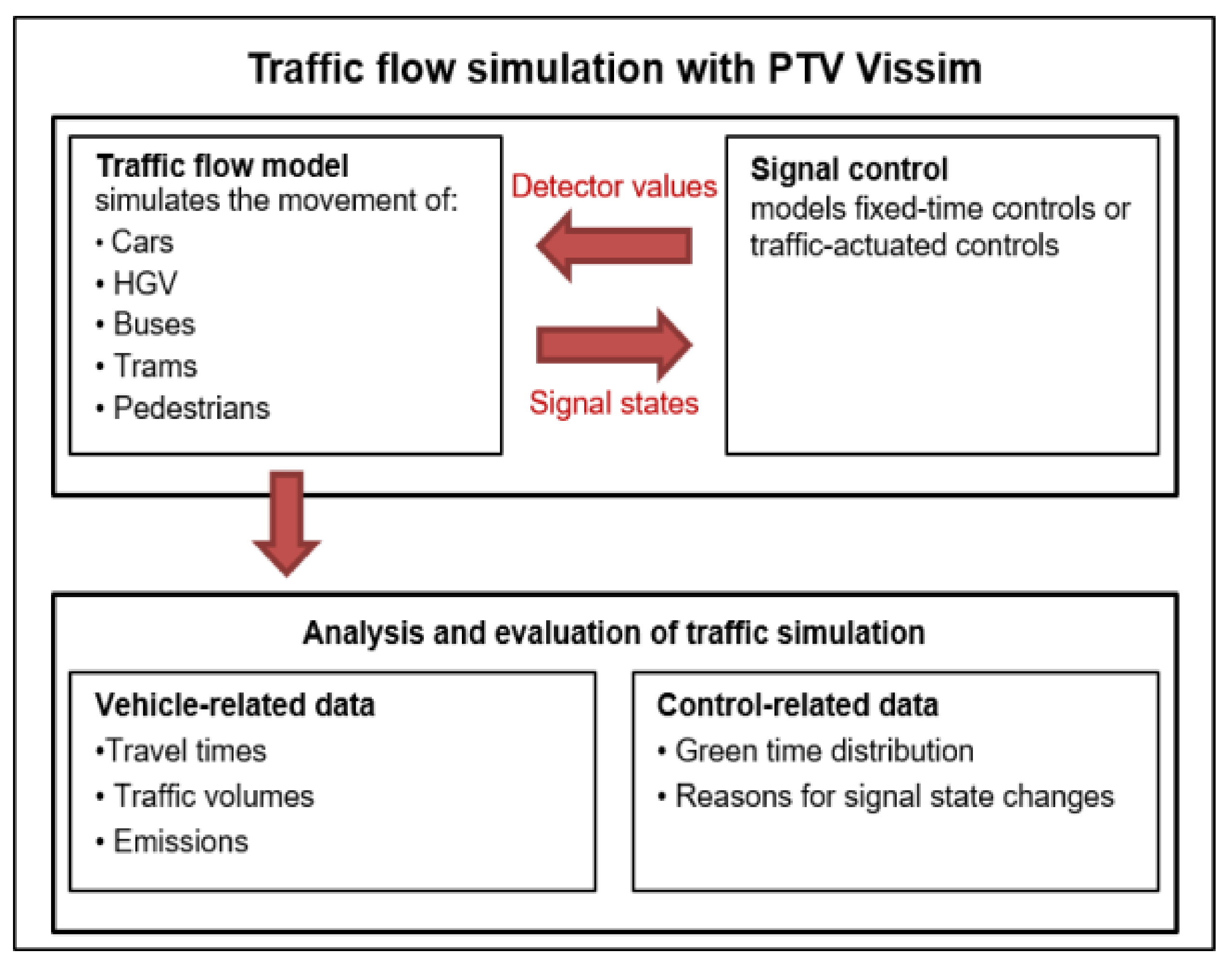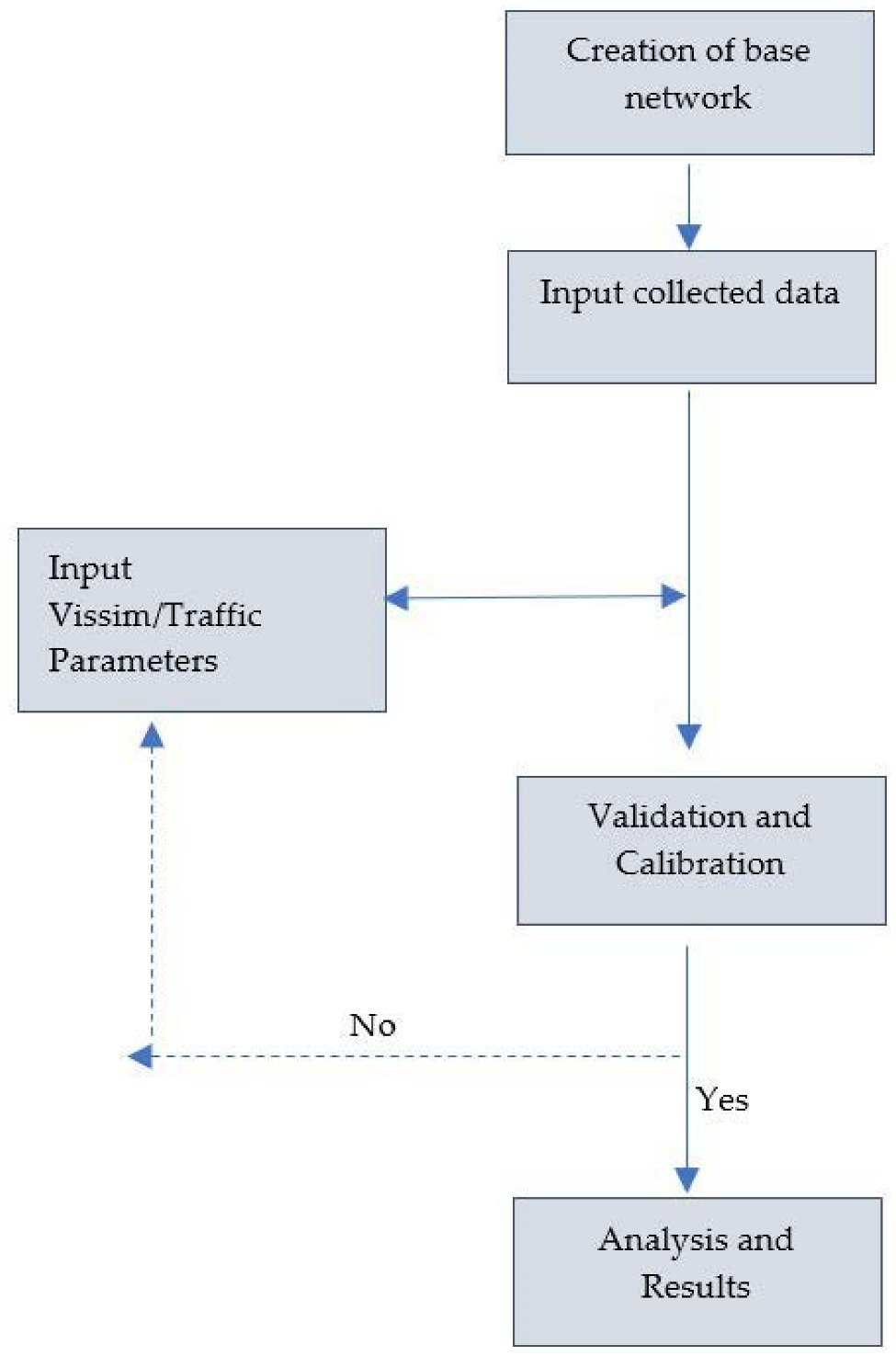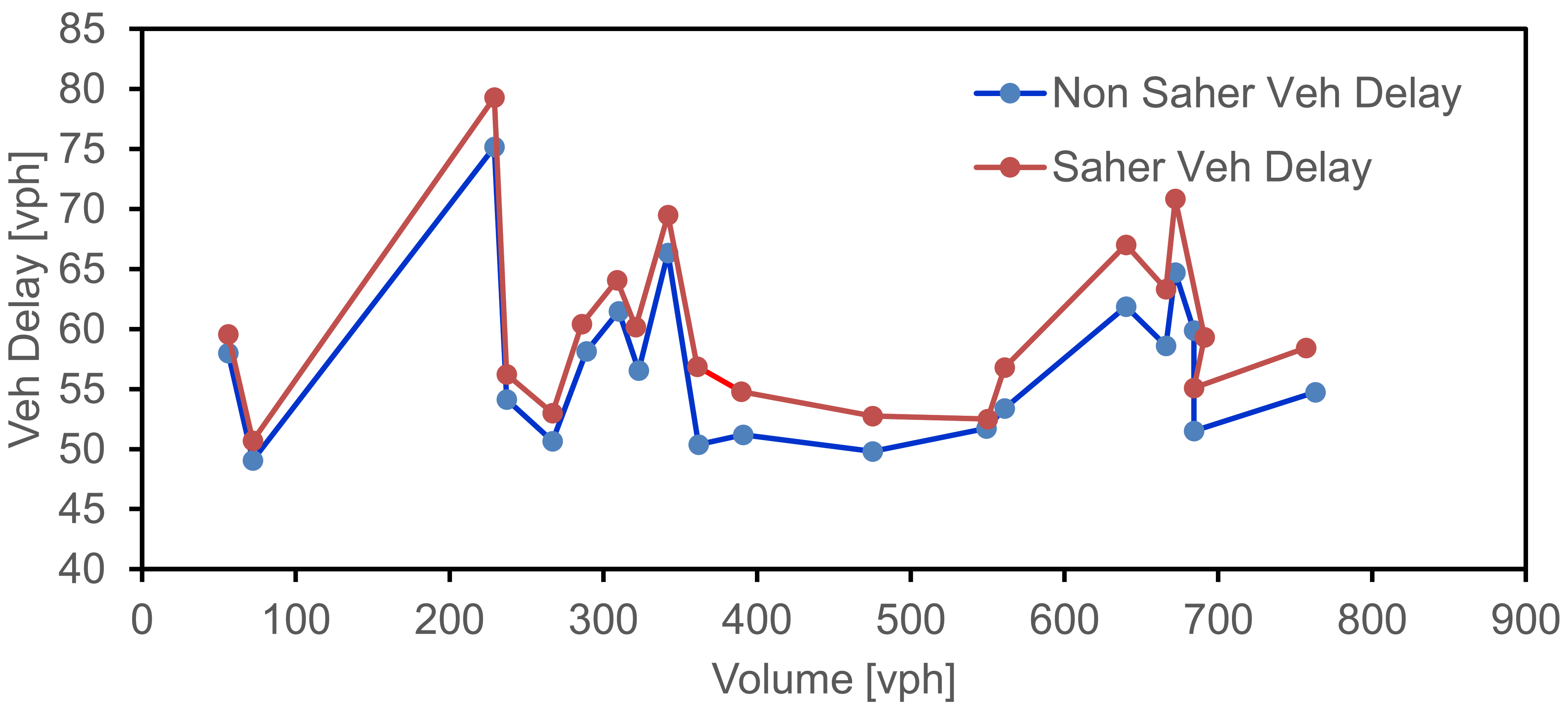Efficiency Assessment of New Signal Timing in Saudi Arabia Implementing Flashing Green Interval Complimented with Law Enforcement Cameras
Abstract
1. Introduction
- To understand and quantify the driver’s behavioral attributes and stop/go decisions when passing through flashing green lights at signalized intersections.
- To investigate the impact of law enforcement red light cameras (SAHER) on driver behavior and operations signalized intersections.
- Comparing the driver behavior and operational performance of flashing green and SAHER systems with regular traffic control (without the impact of the red light camera and flashing green).
2. Related Works
2.1. Effect of Flashing Green
2.2. Effect of Red Light Cameras (RLC)
3. Study Area
4. Data Collection and Description
5. Methodology
5.1. Development of Micro Simulation Model
5.2. Input VISSIM Parameters for SAHER and Non SAHER Intersections
5.3. Traffic Analysis
6. Results and Discussion
6.1. Model Validation
6.2. Effect of Flashing Green on Driver Behavior and Traffic for SAHER versus Non-SAHER Scenarios
6.3. Statistical Analysis for Mean Differences of SAHER versus Non-SAHER Scenarios
7. Conclusions and Recommendations
Author Contributions
Funding
Institutional Review Board Statement
Informed Consent Statement
Data Availability Statement
Acknowledgments
Conflicts of Interest
References
- Jamal, A.; Rahman, M.T.; Al-Ahmadi, H.M.; Ullah, I.M.; Zahid, M. Intelligent Intersection Control for Delay Optimization: Using Meta-Heuristic Search Algorithms. Sustainability 2020, 12, 1896. [Google Scholar] [CrossRef]
- Long, K.; Han, L.D.; Yang, Q. Effects of Countdown Timers on Driver Behavior after the Yellow Onset at Chinese Intersections. Traffic Inj. Prev. 2011, 12, 538–544. [Google Scholar] [CrossRef] [PubMed]
- Huang, M.; Fujita, M.; Wisetjindawat, W. Countdown Timers, Video Surveillance and Drivers’ Stop/Go Behavior: Winter versus Summer. Accid. Anal. Prev. 2017, 98, 185–197. [Google Scholar] [CrossRef] [PubMed]
- Limanond, T.; Chookerd, S.; Roubtonglang, N. Effects of Countdown Timers on Queue Discharge Characteristics of through Movement at a Signalized Intersection. Transp. Res. Part Emerg. Technol. 2009, 17, 662–671. [Google Scholar] [CrossRef]
- Mahalel, D.; Zaidel, D.M. Safety Evaluation of a Flashing-Green Light in a Traffic Signal. Traffic Eng. Control. 1985, 26, 79–81. [Google Scholar]
- Al-Turki, M.; Jamal, A.; Al-Ahmadi, H.M.; Al-Sughaiyer, M.A.; Zahid, M. On the Potential Impacts of Smart Traffic Control for Delay, Fuel Energy Consumption, and Emissions: An NSGA-II-Based Optimization Case Study from Dhahran, Saudi Arabia. Sustainability 2020, 12, 7394. [Google Scholar] [CrossRef]
- Pazzini, M.; Cameli, L.; Lantieri, C.; Vignali, V.; Dondi, G.; Jonsson, T. New Micromobility Means of Transport: An Analysis of E-Scooter Users’ Behaviour in Trondheim. Int. J. Environ. Res. Public Health 2022, 19, 7374. [Google Scholar] [CrossRef]
- Zafri, N.M.; Tabassum, T.; Himal, M.R.H.; Sultana, R.; Debnath, A.K. Effect of Pedestrian Characteristics and Their Road Crossing Behaviors on Driver Yielding Behavior at Controlled Intersections. J. Saf. Res. 2022, 81, 1–8. [Google Scholar] [CrossRef]
- Ahmed, T.; Moeinaddini, M.; Almoshaogeh, M.; Jamal, A.; Nawaz, I.; Alharbi, F. A New Pedestrian Crossing Level of Service (PCLOS) Method for Promoting Safe Pedestrian Crossing in Urban Areas. Int. J. Environ. Res. Public Health 2021, 18, 8813. [Google Scholar] [CrossRef]
- Toledo, T.; Koutsopoulos, H.N.; Davol, A.; Ben-Akiva, M.E.; Burghout, W.; Andréasson, I.; Johansson, T.; Lundin, C. Calibration and Validation of Microscopic Traffic Simulation Tools: Stockholm Case Study. Transp. Res. Rec. 2003, 1831, 65–75. [Google Scholar] [CrossRef]
- Al-Ahmadi, H.M.; Jamal, A.; Reza, I.; Assi, K.J.; Ahmed, S.A. Using Microscopic Simulation-Based Analysis to Model Driving Behavior: A Case Study of Khobar-Dammam in Saudi Arabia. Sustainability 2019, 11, 3018. [Google Scholar] [CrossRef]
- Jamal, A.; Mahmood, T.; Riaz, M.; Al-Ahmadi, H.M. GLM-Based Flexible Monitoring Methods: An Application to Real-Time Highway Safety Surveillance. Symmetry 2021, 13, 362. [Google Scholar] [CrossRef]
- Al-Ahmadi, H.M.; Jamal, A.; Ahmed, T.; Rahman, M.T.; Reza, I.; Farooq, D. Calibrating the Highway Safety Manual Predictive Models for Multilane Rural Highway Segments in Saudi Arabia. Arab. J. Sci. Eng. 2021, 46, 11471–11485. [Google Scholar] [CrossRef]
- Almoshaogeh, M.; Abdulrehman, R.; Haider, H.; Alharbi, F.; Jamal, A.; Alarifi, S.; Shafiquzzaman, M. Traffic Accident Risk Assessment Framework for Qassim, Saudi Arabia: Evaluating the Impact of Speed Cameras. Appl. Sci. 2021, 11, 6682. [Google Scholar] [CrossRef]
- Jamal, A.; Zahid, M.; Tauhidur Rahman, M.; Al-Ahmadi, H.M.; Almoshaogeh, M.; Farooq, D.; Ahmad, M. Injury Severity Prediction of Traffic Crashes with Ensemble Machine Learning Techniques: A Comparative Study. Int. J. Inj. Control. Saf. Promot. 2021, 28, 408–427. [Google Scholar] [CrossRef] [PubMed]
- Jamal, A.; Rahman, M.T.; Al-Ahmadi, H.M.; Mansoor, U. The Dilemma of Road Safety in the Eastern Province of Saudi Arabia: Consequences and Prevention Strategies. Int. J. Environ. Res. Public Health 2020, 17, 157. [Google Scholar] [CrossRef]
- Zahid, M.; Jamal, A.; Chen, Y.; Ahmed, T.; Ijaz, M. Predicting Red Light Running Violation Using Machine Learning Classifiers. In Green Connected Automated Transportation and Safety; Springer: Berlin/Heidelberg, Germany, 2022; pp. 137–148. [Google Scholar]
- Almadi, A.I.M.; Al Mamlook, R.E.; Almarhabi, Y.; Ullah, I.; Jamal, A.; Bandara, N. A Fuzzy-Logic Approach Based on Driver Decision-Making Behavior Modeling and Simulation. Sustainability 2022, 14, 8874. [Google Scholar] [CrossRef]
- Moslem, S.; Farooq, D.; Jamal, A.; Almarhabi, Y.; Almoshaogeh, M.; Butt, F.M.; Tufail, R.F. An Integrated Fuzzy Analytic Hierarchy Process (AHP) Model for Studying Significant Factors Associated with Frequent Lane Changing. Entropy 2022, 24, 367. [Google Scholar] [CrossRef]
- Farooq, D.; Moslem, S.; Jamal, A.; Butt, F.M.; Almarhabi, Y.; Faisal Tufail, R.; Almoshaogeh, M. Assessment of Significant Factors Affecting Frequent Lane-Changing Related to Road Safety: An Integrated Approach of the AHP–BWM Model. Int. J. Environ. Res. Public Health 2021, 18, 10628. [Google Scholar] [CrossRef]
- Zahid, M.; Chen, Y.; Khan, S.; Jamal, A.; Ijaz, M.; Ahmed, T. Predicting Risky and Aggressive Driving Behavior among Taxi Drivers: Do Spatio-Temporal Attributes Matter? Int. J. Environ. Res. Public Health 2020, 17, 3937. [Google Scholar] [CrossRef]
- Becker, M. A Study of the Effect of a “Flashing Green” Phase in Traffic Signals at Urban Intersections; Technion Research and Development Foundation Ltd.: Haifa, Israel, 1971. [Google Scholar]
- Hakkert, A.-S.; Mahalel, D. Effect of Traffic Signals on Road Accidents–with Special Reference to the Introduction of a Blinking Green Phase. Traffic Eng. Control. 1978, 19, 212–215. [Google Scholar]
- Köll, H.; Bader, M.; Axhausen, K.W. Driver Behaviour during Flashing Green before Amber: A Comparative Study. Accid. Anal. Prev. 2004, 36, 273–280. [Google Scholar] [CrossRef]
- Shen, J.; Wang, W. Effects of Flashing Green on Driver’s Stop/Go Decision at Signalized Intersection. J. Cent. South Univ. 2015, 22, 771–778. [Google Scholar] [CrossRef]
- Awad, W. Drivers’ Behavior at Signalized Intersections Operating with Flashing Green: Comparative Study. Civ. Environ. Res. 2014, 36, 273–280. [Google Scholar]
- Kocić, A.; Čelar, N.; Kajalić, J.; Stanković, S. Flashing Green Effects on Traffic Efficiency. J. Road Traffic Eng. 2020, 66, 27–31. [Google Scholar] [CrossRef]
- Dong, S.; Shen, F.; Jiang, L.; Ye, K. Research on the Impact of Flashing Green Lights on E-Bike Drivers’ Behavior. In CICTP 2014: Safe, Smart, and Sustainable Multimodal Transportation Systems; ASCE: Reston, VA, USA, 2014; pp. 2185–2191. [Google Scholar]
- Factor, R.; Prashker, J.N.; Mahalel, D. The Flashing Green Light Paradox. Transp. Res. Part Traffic Psychol. Behav. 2012, 15, 279–288. [Google Scholar] [CrossRef]
- Huang, H.; Wang, D.; Zheng, L.; Li, X. Evaluating Time-Reminder Strategies before Amber: Common Signal, Green Flashing and Green Countdown. Accid. Anal. Prev. 2014, 71, 248–260. [Google Scholar] [CrossRef]
- Hussain, Q.; Alhajyaseen, W.; Brijs, K.; Pirdavani, A.; Brijs, T. Improved Traffic Flow Efficiency during Yellow Interval at Signalized Intersections Using a Smart Countdown System. IEEE Trans. Intell. Transp. Syst. 2020, 23, 1959–1968. [Google Scholar] [CrossRef]
- Tang, K.; Xu, Y.; Wang, P.; Wang, F. Impacts of Flashing Green on Dilemma Zone Behavior at High-Speed Intersections: Empirical Study in China. J. Transp. Eng. 2015, 141, 04015005. [Google Scholar] [CrossRef]
- Palat, B.; Delhomme, P. A Simulator Study of Factors Influencing Drivers’ Behavior at Traffic Lights. Transp. Res. Part Traffic Psychol. Behav. 2016, 37, 107–118. [Google Scholar] [CrossRef]
- Baratian-Ghorghi, F.; Zhou, H.; Wasilefsky, I. Effect of Red-Light Cameras on Capacity of Signalized Intersections. J. Transp. Eng. 2016, 142, 04015035. [Google Scholar] [CrossRef]
- Sun, J.; Dong, S.; Bing, X.; Ni, Y. Comparative Study of Impacts of Red Light Cameras in China. Transp. Res. Rec. 2012, 2317, 68–75. [Google Scholar] [CrossRef]
- Almutairi, O.; Wei, H. Effect of Speed/Red-Light Cameras and Traffic Signal Countdown Timers on Dilemma Zone Determination at Pre-Timed Signalized Intersections. Accid. Anal. Prev. 2021, 154, 106076. [Google Scholar] [CrossRef] [PubMed]
- Baratian-Ghorghi, F.; Zhou, H.; Franco-Watkins, A. Effects of Red Light Cameras on Driver’s Stop/Go Decision: Assessing the Green Extension Hypothesis. Transp. Res. Part Traffic Psychol. Behav. 2017, 46, 87–95. [Google Scholar] [CrossRef]
- Baratian-Ghorghi, F.; Zhou, H. Effects of Photo Enforcement Cameras on Intersection Delays and Driver Behavior. In Proceedings of the Transportation Research Board 95th Annual Meeting, Washington, DC, USA, 10–14 January 2016. [Google Scholar]
- Jha, M.K.; Weldegiorgis, Y. A Probabilistic Approach to Calculate Capacity of Signalized Intersections with a Red Light Camera. J. Adv. Transp. 2014, 48, 348–361. [Google Scholar] [CrossRef]
- Gates, T.; Savolainen, P.T.; Maria, H.-U. Impacts of Automated Red Light Running Enforcement Cameras on Driver Behavior. 2014. Available online: https://trid.trb.org/view/1287560 (accessed on 5 October 2022).
- Manual, H.C. HCM2010; Transportation Research Board; National Research Council: Washington, DC, USA, 2010; p. 1207. [Google Scholar]
- Al-Ahmadi, H.M.; Reza, I.; Jamal, A.; Alhalabi, W.S.; Assi, K.J. Preparedness for Mass Gatherings: A Simulation-Based Framework for Flow Control and Management Using Crowd Monitoring Data. Arab. J. Sci. Eng. 2021, 46, 4985–4997. [Google Scholar] [CrossRef]
- Marshall, R.L. An Empirical Assessment of the Impact of Red Light Cameras on the Capacity of Urban Signalized Intersections; Morgan State University: Baltimore, MD, USA, 2006. [Google Scholar]
- Nagy, J.; Lakatos, I. Possibilities of Using of Online Vehicle Diagnostics in the Future. In Vehicle and Automotive Engineering; Springer: Berlin/Heidelberg, Germany, 2023; pp. 71–83. [Google Scholar]
- Lakatos, I.; Szauter, F.; Pup, D.; Nagy, A. Alternative Propulsion Buses in the Metropolitan Public Transport. In Vehicle and Automotive Engineering; Springer: Berlin/Heidelberg, Germany, 2020; pp. 49–66. [Google Scholar]





| Sr. No | Signalized Intersections | Area | RLC/SAHER | |
|---|---|---|---|---|
| 1 | Herfy Intersection– Prince Sultan and Shabili road | Unayzah | Yes | |
| 2 | Sa’a Intersection– King Abdulaziz and Shabili road | Unayzah | Yes | |
| 3 | Khandak Intersection– Umar bin Khattab and West ring road | Unayzah | Yes | |
| 4 | Burj Intersection– King Abdulaziz and Prince Faisal road | Buraydah | Yes | |
| 5 | Qanat Intersection– King Faisal and Al Qanat road | Buraydah | Yes | |
| Sr No. | Parameters within VISSIM | SAHER or RLC with Flashing Green |
|---|---|---|
| 1 | Standstill distance for first vehicle before Traffic Signal | Selected value of 1 m Video analysis of signals show cars standing well before the stopping line to avoid ticket |
| 2 | Behavior at the red/amber state of the signal | Stop (same as red) based on video analysis |
| 3 | Reaction time distribution | 1.60–1.65 s based on video analysis |
| 4 | Reaction to amber signal | Default values in VISSIM |
| 5 | CC0 (Standstill distance) CC1 (Headway time) | CC0 = 2.5 m CC1 = 2.2 s based on video analysis |
| Sr No. | Parameters within VISSIM | No SAHER or RLC without Flashing Green |
|---|---|---|
| 1 | Standstill distance for first vehicle before Traffic Signal | Not selected If this option is not selected, the vehicles use a normally distributed random value |
| 2 | Behavior at red/amber state of signal | Go (Same as green) based on video analysis |
| 3 | Reaction time distribution | No time distribution selected the vehicles use a normally distributed random value |
| 4 | Reaction to amber signal | Default values for a state where cars continue driving for longer when there is an amber light VISSIM |
| 5 | CC0 (Standstill distance) CC1 (Headway) | Default values of VISSIM |
| Sr No | Movements/Approaches | Maximum Queue Model Result | Maximum Queue Data Result | Percentage Difference |
|---|---|---|---|---|
| Herfy Intersection | Prince Sultan NB | 94 | 94 | 0.00% |
| Prince Sultan SB | 77 | 76 | 1.32% | |
| Ash Shabili WB | 123 | 122 | 0.82% | |
| Ash Shabili EB | 140 | 130 | 7.69% | |
| Average Queue Lengths | 108.5 | 105.5 | 2.8% | |
| Sa’a Intersection | King Abdulaziz NB | 67 | 62 | 8.06% |
| King Abdulaziz SB | 68 | 62 | 9.68% | |
| Ash Shabili WB | 83 | 76 | 9.21% | |
| Ash Shabili EB | 90 | 88 | 2.27% | |
| Average Queue Lengths | 77 | 72 | 6.9% | |
| Burj Intersection | King Abdulaziz NB | 109 | 120 | 9.17% |
| King Abdulaziz SB | 108 | 100 | 8.00% | |
| Prince Faisal WB | 53 | 50 | 6.00% | |
| Prince Faisal EB | 42 | 40 | 5.00% | |
| Average Queue Lengths | 78 | 77.5 | 0.6% | |
| Khandak Intersection | Abubakr Street NB | 96 | 93 | 2.95% |
| Abubakr Street SB | 81 | 77 | 4.83% | |
| Umar Street WB | 81 | 80 | 1.66% | |
| Umar Street EB | 54 | 55 | 0.95% | |
| Average Queue Lengths | 78 | 76.25 | 2.3% | |
| Qanat Intersection | Qanat Street NB | 102 | 95 | 7.45% |
| Qanat Street SB | 76 | 78 | 2.60% | |
| King Faisal Street WB | 81 | 82 | 1.29% | |
| King Faisal Street EB | 96 | 102 | 5.43% | |
| Average Queue Lengths | 88.7 | 89.2 | 0.6% |
| Intersections | SAHER/RLC | Non-SAHER/NO RLC | Percentage Difference in Delay |
|---|---|---|---|
| Average Vehicle Delay (sec) | Average Vehicle Delay (sec) | ||
| Herfy Intersection | 71.90 | 67.31 | −7% |
| Sa’a Intersection | 55.87 | 54.70 | −2% |
| Burj Intersection | 60.92 | 57.53 | −6% |
| Khandak Intersection | 62.35 | 59.82 | −4% |
| Qanat Intersection | 57.44 | 54.57 | −5% |
| Intersections | SAHER/RLC | Non SAHER/NO RLC | Percentage Difference in Queue Length |
|---|---|---|---|
| Qlen Max (m) | Qlen Max (m) | ||
| Herfy Intersection | 109 | 90 | −21% |
| Sa’a Intersection | 77 | 68 | −12% |
| Burj Intersection | 78 | 69 | −13% |
| Khandak Intersection | 78 | 64 | −22% |
| Qanat Intersection | 89 | 76 | −17% |
| Parameters | Mean | Std. Deviation | Std. Error Mean | 95% Confidence Interval of the Difference | ||
|---|---|---|---|---|---|---|
| Lower | Upper | |||||
| Qlen (m) Y1 | Y1 Y1N | 12.87450 | 7.10437 | 1.12330 | 10.60241 | 15.14659 |
| Veh delay (s) Y3 | Y3 Y3N | 2.90250 | 1.65821 | 0.26219 | 2.37218 | 3.43282 |
| Parameters in Question | t | Sig. (2-Tailed) | |
|---|---|---|---|
| Qlen (m) Y1 | Y1 Y1N | 11.461 | 4.69 × 10−14 |
| Veh delay (s) Y3 | Y3 Y3N | 11.070 | 1.33 × 10−13 |
Publisher’s Note: MDPI stays neutral with regard to jurisdictional claims in published maps and institutional affiliations. |
© 2022 by the authors. Licensee MDPI, Basel, Switzerland. This article is an open access article distributed under the terms and conditions of the Creative Commons Attribution (CC BY) license (https://creativecommons.org/licenses/by/4.0/).
Share and Cite
Alfawzan, M.S.; Aftab, A. Efficiency Assessment of New Signal Timing in Saudi Arabia Implementing Flashing Green Interval Complimented with Law Enforcement Cameras. Sustainability 2022, 14, 14879. https://doi.org/10.3390/su142214879
Alfawzan MS, Aftab A. Efficiency Assessment of New Signal Timing in Saudi Arabia Implementing Flashing Green Interval Complimented with Law Enforcement Cameras. Sustainability. 2022; 14(22):14879. https://doi.org/10.3390/su142214879
Chicago/Turabian StyleAlfawzan, Mohammed Saleh, and Ahmad Aftab. 2022. "Efficiency Assessment of New Signal Timing in Saudi Arabia Implementing Flashing Green Interval Complimented with Law Enforcement Cameras" Sustainability 14, no. 22: 14879. https://doi.org/10.3390/su142214879
APA StyleAlfawzan, M. S., & Aftab, A. (2022). Efficiency Assessment of New Signal Timing in Saudi Arabia Implementing Flashing Green Interval Complimented with Law Enforcement Cameras. Sustainability, 14(22), 14879. https://doi.org/10.3390/su142214879






